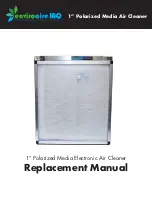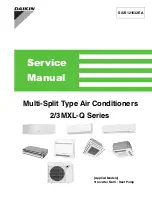
Step 10—Start-Up and Check Charge
To prevent compressor damage or personal injury, observe
the following:
• Do not overcharge system with refrigerant.
• Do not operate unit in a vacuum or at negative pressure.
• Do not disable low-pressure switch
In scroll compressor applications:
• Dome temperatures may be hot.
• In 3 phase application, incorrect phasing will cause reverse
rotation, resulting in elevated noise levels, equalized pres-
sures and reduced current draw. Correct by reversing power
connection L1 and L2 on contactor.
To prevent personal injury wear safety glasses, protective
clothing, and gloves when handling refrigerant and observe
the following:
• Back seating service valves are not equipped with Schrader
valves. Fully back seat (counter clockwise) valve stem before
removing gage port cap.
• Front seating service valves are equipped with Schrader
valves.
Do not vent refrigerant to atmosphere. Recover during system
repair or final unit disposal.
Follow these steps to start up the system:
1. Fully back seat (open) liquid and vapor tube service valves.
2. Unit is shipped with valve stem(s) front seated (closed) and
caps installed. Replace stem caps after system is opened to
refrigerant flow. Replace caps finger-tight and tighten with
wrench an additional 1/12 turn.
3. Close electrical disconnects to energize system.
4. Set room thermostat at desired temperature. Be sure set point
is below indoor ambient temperature.
5. Set room thermostat at COOL and fan control at ON or AUTO
mode, as desired. Operate unit for 15 minutes. Check system
refrigerant charge.
SEQUENCE OF OPERATION — Turn on power to indoor and
outdoor units. Transformer is energized.
On a call for cooling, the thermostat makes circuits R-Y and R-G.
Circuit R-Y energizes contactor, starting outdoor fan motor and
compressor circuit. R-G energizes the indoor unit blower relay,
starting the indoor blower motor on high speed.
When the thermostat is satisfied, its contacts open, de-energizing
contactor and blower relay. Compressor and motors stop.
If indoor unit is equipped with a time-delay relay circuit, the
indoor blower will run an additional 90 seconds to increase system
efficiency.
Step 11—Check Charge
UNIT CHARGE — Factory charge is shown on unit rating plate.
Adjust charge by following procedure shown on charging tables
located on unit.
NOTE:
If superheat or subcooling charging conditions are not
favorable, charge must be weighed in accordance with unit rating
plate
±
0.6 oz/ft of 3/8-in. liquid line above or below 15 ft
respectively.
EXAMPLE:
25 ft - 15 ft = 10 ft X 0.6 oz/ft = 6 oz of additional charge
COOLING ONLY PROCEDURE — The following procedure is
valid when indoor airflow is within
±
21% of its rated CFM.
1. Operate unit a minimum of 10 minutes before checking
charge.
2. Measure suction pressure by attaching an accurate gage to
suction valve service port.
3. Measure suction temperature by attaching an accurate ther-
mistor type or electronic thermometer to suction line at service
valve.
4. Measure outdoor air dry-bulb temperature with thermometer.
5. Measure indoor air (entering indoor coil) wet-bulb tempera-
ture with a sling psychrometer.
6. Refer to Table 3. Find outdoor temperature and evaporator
entering air wet-bulb temperature. At this intersection, note
superheat.
7. Refer to Table 4. Find superheat temperature located in item 6
and suction pressure. At this intersection, note suction line
temperature.
8. If unit has a higher suction line temperature than charted
temperature, add refrigerant until charted temperature is
reached.
9. If unit has a lower suction line temperature than charted
temperature, reclaim refrigerant until charted temperature is
reached.
10. If outdoor air temperature or pressure at suction valve
changes, charge to new suction line temperature indicated on
chart.
Step 12—Final Checks
IMPORTANT:
Before leaving job, be sure to do the following:
1. Securely fasten all panels and covers.
2. Tighten service valve stem caps to 1/12-turn past finger tight.
3. Leave User’s Manual with owner. Explain system operation
and periodic maintenance requirements outlined in manual.
4. Fill out Dealer Installation Checklist and place in customer
file.
CARE AND MAINTENANCE
For continuing high performance and to minimize possible equip-
ment failure, periodic maintenance must be performed on this
equipment.
Frequency of maintenance may vary depending on geographic
areas, such as coastal applications, which may require more
frequent maintenance.
7


























